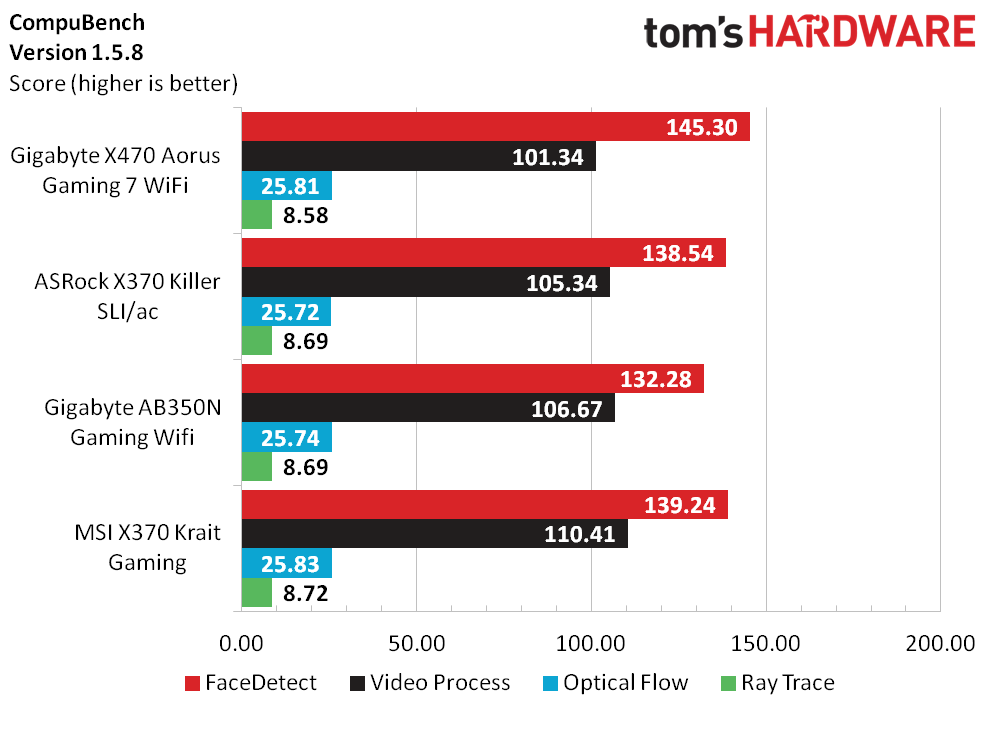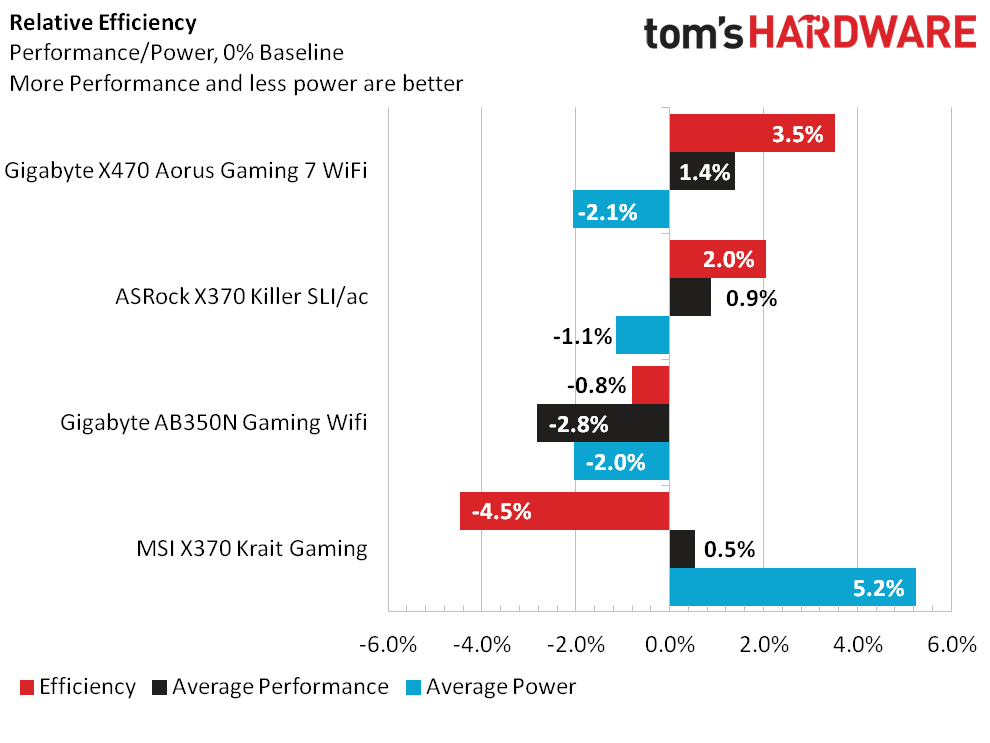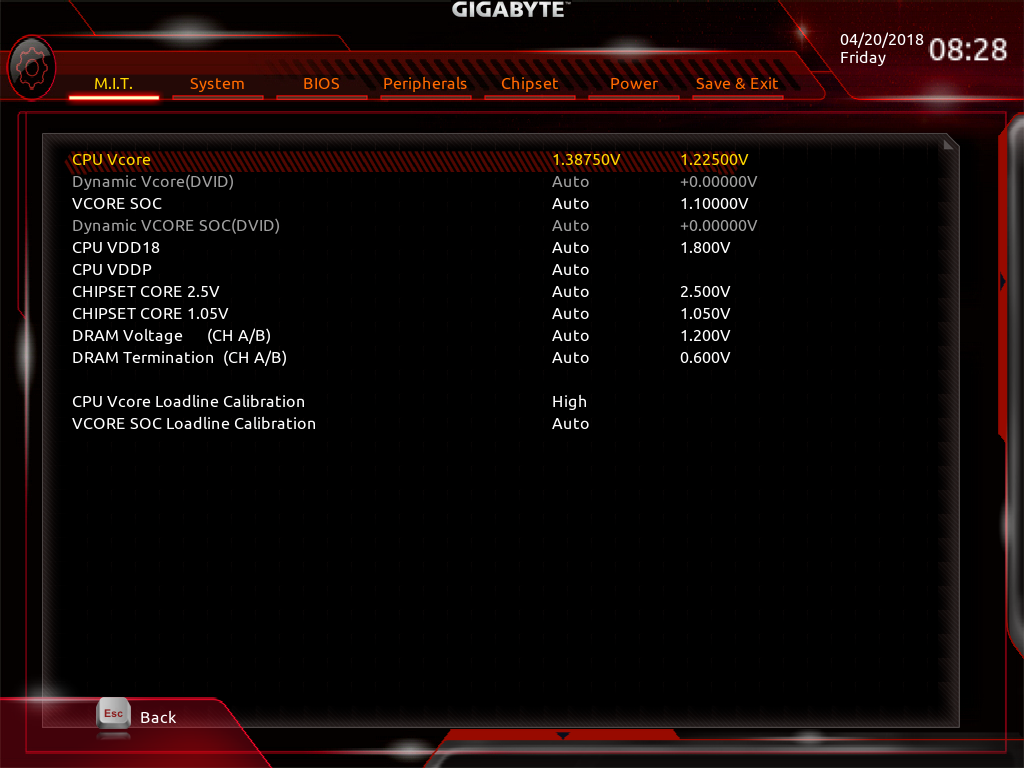Gigabyte X470 Aorus Gaming 7 WiFi Review: AM4 Grows Up
Why you can trust Tom's Hardware
Benchmark Results & Final Analysis
Synthetics & Applications



When Ryzen originally launched, Cinebench R15 was the go-to metric to show the advantages of extra cores and threads. Though the 2nd Gen Ryzen processors boast instruction-per-clock increases, this X470 platform still hums right along with the older boards and establishes a 1% increase over the averages for both single and multi-core metrics. Compubench shows mixed results with the FaceDetect workload coming ahead, while the Video Process test lags behind when exercising this GPU-focused workload. PCMark shows middle-of-the pack performance on average for the Gigabyte X470 Aorus Gaming 7 board, landing only 0.5% above the average across samples.




Sandra starts to hammer some of the more board-design-centric changes, with memory bandwidth landing 3.5% ahead of the 2nd place contender and besting the dual-DIMM board by nearly 7%. Arithmetic shows wins in the remaining categories, most notably with the cryptography workload landing 3% ahead of the MSI X370 Krait. Going forward, we plan to present IOmeter data comparing NVMe IOPS and MB/s measurements for sequential and random reads and writes. But for now, PCMark’s Storage metric shows a virtual dead heat for 3 of the 4 boards.



Graphical synthetics are fairly consistent across our test samples, despite minor variations in driver or OS levels. The Skydiver workload’s 720p resolution boasts some impressive numbers for the Aorus Gaming 7 WiFi, but that lead begins to dwindle as the graphical load increases on the GTX 970. The Krait does very well with keeping up, but again the deltas are minor when looking at Firestrike.




The trend continues with the application workloads where the X470 Aorus Gaming 7 W-Fi is able to squeeze 30 seconds off the Killer at Handbrake, as well as shaving precious seconds off the contenders in Blender. Unfortunately, the AB350N was having a bad compression day when we ran the 7-zip workload, but as for the X470 it works just as well as its peers. Adobe seems to not favor the X470 this time around, though the three remaining boards take a win at various other spots on the chart.
Games
For our purposes today, we’ll only be factoring in 1080p results towards the overall performance metric, because we don't yet have enough data for 4k results yet, though we do have higher resolution results for some games.




With that out of the way, Ashes of the Singularity: Escalation is taking advantage of the slight improvements in power delivery on this board, and is able to squeeze out a couple of extra frames at 1080p and the High preset. On the game's Crazy setting, 1080p levels the playing field somewhat, and both Gigabyte boards are nearly identical. At higher resolutions and detail settings, we see the ASRock X370 Killer SLI/ac take the lead by nearly 2 frames. It is important to note that the Krait was tested at the Surround Resolution of 3460x1920, which attributes its lower detail win.


F1 2015 is one of those games we intend on upgrading in the near future. But for now, Ultra High presets are playable across the board for all resolutions. The Gigabyte AB350N’s unusually low result was repeatable, so it’s interesting to see the X470 Aorus Gaming 7 WiFi best it by nearly 24% when comparing averages. Things improve slightly for the AB350 at 4k, and only 3 frames separate it from the X470. F1 2015 scales fairly well with resolution, so it’s expected to see the Krait perform well here.
Get Tom's Hardware's best news and in-depth reviews, straight to your inbox.




We are observing some oddities with the latest Windows update that causes Metro Last Light’s benchmark utility to have a hard time starting consistently across resolution changes. However, test data is repeatable and the X470 Aorus Gaming 7 WiFi takes a huge hit with 1080p high performance. Increasing to the Very High quality setting appears to level things out, where all boards fall within 3 percentage points of each other. Metro scales well with resolution, and all boards perform well when comparing the average metric.




The Talos Principle continues to haunt this reviewer’s dreams, and at 1080p medium and ultra settings, the ASRock X370 Killer nudges past all three contenders by two-to-12 frames. The trend continues at 4k resolutions, but the increase in resolution and detail tighten the gaps significantly. A funny observation: despite having fewer pixels to generate, the Krait still is unable to perform up to par with the other boards.
Power, Thermals, Performance, and Efficiency
Up to this point, the ASRock X370 Killer SLI/ac has been our reigning efficiency king, but the X470’s design improvements reveal their handiwork here. At idle, we are within the margin of error for the Kill-A-Watt socket power draw measurement device. However, saving five watts at full CPU load and 17 at full system load help reduce this system’s power footprint. It’s also interesting that a board with nearly half the IO and board real estate manages to draw similar wattage compared to this premier board.


Now temperature is a tricky subject, so let’s walk through it carefully. The Gigabyte X470 and AB350N both use the Corsair H110i for cooling, and their CPU measurements reflect that when compared against the air-based coolers. The X470 is using a newer version of AIDA64, so that is likely the attributing factor to the CPU versus CPU1 Diode delta. Comparing the air-cooled (Noctua U12S) data shows a fairly similar trend. The big takeaway from this chart is the voltage regulator temperatures. We are still using the same IR thermometer from launch day, and it is clear that the fin stack design on the X470 is 10C better than the air-cooled samples. Fan configuration on the chassis hasn’t changed, so it is even more compelling, because the AB350N shows a 35C degree difference in temperatures!
While still utilizing the same components as the X370 review samples, the Gigabyte X470 Aorus Gaming 7 WiFi’s performance manages to come ahead in three of the four genres of benchmarks, after factoring in all of the averages and test samples. Granted, several wins are by less than a percentage point, but we’ve got much more to geek out over with this product.


As we alluded to earlier, given the power draw improvements of this design and the impressive performance throughout our tests, the Gigabyte X470 Aorus Gaming 7 Wifi manages to come out ahead of the Killer SLI/ac by 1.5%. The Krait doesn’t appear to perform as well in this particular chart, but more importantly, it is drawing 7.3% more power on average than our newly crowned efficiency king.
Overclocking – Criticism Builds Success
Let’s talk CPU overclocking first. We’ve shared on several occasions the lackluster performance from the particular 1700X sample we use for testing motherboards. However, it is predictable and provides a great reference for a board’s ability to withstand harsh conditions. We tried three different UEFI versions for this board, all of which provided similar results in overclocking. Our first step was to bump the multiplier from AUTO to 38. Success is achieved, but moving up to 38.5 forces us to move to the load line setting to HIGH. An average overclock for our old methodology was achieved with 3875MHz and 1.3875V set through the UEFI, which is well within the acceptable territory for longevity.




Eager to test out this board’s Vreg cooling, we threw out the usual playbook and kept going. Increasing the voltage to 1.4075V made 3900MHz stable, but going any higher required an additional 55mV of voltage. Our official Prime95 overclock came to 3950MHz at 1.525V for an eight-hour torture test. To our amazement, the Vregs measured in at only 62C while the system was burning 282 watts! To make things better, the same settings allowed us to achieve an eight-hour FPU stress through AIDA64 with 4.0GHz. Nice job, Gigabyte! As long as sufficient airflow is flowing over the Vreg heatsink, this board can easily source more than the allowable maximum circuit voltage of 1.45V for our Ryzen 1700X. We intend on covering Ryzen 2000 series overclocking in our next X470 article.




After cooling down a bit, it’s time to turn on XMP. Memory overclocking follows the same procedure as before: we increment the multiplier until the system fails to survive stress tests. Since we run a fully populated DIMM configuration, seeing DDR4-2933 would be a great start. Right out of the shoot, the Gigabyte X470 Aorus Gaming 7 Wifi hit DDR4-3200 through XMP settings! How about DDR4-3333? It runs smoothly. Feeling bullish, we tried DDR4-3466. It booted, but wouldn't run any of our stress tests. We do not know if it’s the X470 physical design guidelines or Gigabyte’s settings, but this overclock improves our DDR4 bandwidth by 35% with zero additional tuning. On second thought, maybe we will show off that Aorus VIP card on social media!


Clearly, improvements were made on this iteration of the AMD chipset lineup that has measurable gains on our test bed. As always, our results might not be typical, but it sure feels good to hit a set of stable, higher numbers.
Value & Conclusions
It is difficult to justify “value” comparing 1-year-old products against brand new high-end products. Still, it’s important to factor in cost because not everyone is primarily interested in performance. With pricing ranging from $240 to $300 at the time of this writing, it's difficult for the Gigabyte X470 Aorus Gaming 7 WiFi to win outright. With as-tested benchmarks averaged out, this board runs on par with our two other highly rated boards for the X370 platform. On pricing, even if the AB350N is removed from the metric, a $90 difference is hard to swing unless we want to start factoring in platform costs. But the bundled performance, stability, and design features help this reviewer justify the additional cost for a premium board.
However, $240 seems to be a reasonable price for a top-tier board if it’s available. With new Taichis, Crosshairs, Primes, and M7s landing on shelves, it’ll be interesting to see how prices go moving forward. If the B350 vs X370 comparisons translate to the eventual “B450,” or whatever AMD's new stepped-down chipset gets called, getting even better performance from tighter memory and power control designs on a less-expensive board could translate to a better deal, though.
With all that said, do we recommend the Gigabyte X470 Aorus Gaming 7 Wifi? Yes. Gigabyte delivers on customer feedback and provides performance, flair, overclocking, and expandability options that should please any builder that with a windowed case to show off the luxe lighting. As this is our first X470 motherboard, we're only left wondering if the competition can deliver even better performance.
MORE: Best Motherboards
MORE: How To Choose A Motherboard
MORE: All Motherboard Content
-
jhensjh Exactly which memory are you using for these tests? From the How We Test Page: "G.Skill still provides our test stand with two of their 2x8GB dual-channel DDR4-3200 TridentZ kits." Yet this same page provides a purchase link listed as "test hardware" For Gskill FlareX, a different product to my knowledge. And on the Benchmarks and & Rating page, your chart specifies HyperX Predatior 4x8GB, a Kingston product if I'm not mistaken.Reply -
TheTerk RAM used in our X370 and X470 test bench is the F4-3200C14D-16GTZR kit. Flare-X RAM is used in our X399 test bench. Long long ago we tested with the HyperX DD4-3200MHz kit, which is probably why that chart referenced the kit.Reply
Regardless, each of these kits would likely perform exceptionally well on this platform with the improvements to the design specifications listed by AMD. We can always try different kits in future reviews if that's something y'all want to see. -
cknobman I have an Arous Gaming 7 x370 motherboard and have issues flush mounting my 1080TI on the board because of that stupid cover they placed on it.Reply
I see that cover on this board as well, were there issues mounting graphics cards? -
alextheblue ReplyPerhaps removing the 2nd M.2 slot in favor of additional SATA3 ports would better suit more builders, as the Gen2 M.2 is under-utilizing the interface.
There's already plenty of SATA ports for the vast majority. Don't take away the second M.2. Slower is fine for a secondary M.2, slower/bigger/cheaper (per GB). -
Gillerer ReplyStorage options are above average for the X470 Aorus Gaming 7 WiFi, with 6 right-angled SATA3 connectors and access to two M.2 slots for smaller form-factor drives. The top M2A socket supports full PCIe Gen3 x4 NVMe and SATA3 drives, while the M2B slot provides PCIe Gen2 x4 and SATA3 support. Gigabyte’s marketing material touts the board’s ability to support M.2 RAID arrays, but given the PCIe disparity on this mainstream platform, we won’t be expecting RAID performance that's possible with the X399 platform.
You can use the second PCIe 3.0 x16@x8 slot to add a second M.2 NVMe drive, and therefore have two connected directly to the CPU. I don't know whether using an adapter for two (or more, if using a PCIe switch chip) M.2 drives in the slot is possible - that would be something for reviewers to find out from the manufacturer and/or test. -
christopheabegg 6 sata 3 are more that enough , sata3 is saturated with SSD . An upgrade to M2 is the way to performance and the availability of raid on M2 is the killer addition . SLI and crossfire are no longer officially supported (or as is) on future driver , the second graphic slot is questionable and could be filled with a 10Gbt 4 lane card .Reply
The real problem of theses motherboards are :
the bling bling led stuff power consumption
the inadequate power regulator (good for nitrogen overclocking) you paid for over the top performance (perhaps for the dream of a 150W 2800X) .
the inadequate power FET radiator if the motherboard mounting is vertical (that's a classical case) 70% of the fins ares horizontal (likely inefficient) .
I prefer the gaming 5 with a little less over the top power delivery and less led bling , correctly oriented fins and same services . -
christopheabegg The Wifi chip is the latest ac Wave 2 spec with Bluetooth 5 that include MUMIMO dual band 160Mhz channel . You can achieve gigabit speed with the adequate Wave 2 router at 5m and alone . But think a chipo 5m CAT 5e cable do the same with less lag and better stability .Reply -
bit_user In case anyone cares, this is currently Gigabyte's only X470 mobo that supports ECC RAM (in ECC mode). According to their website, that is. The reviewer could've mentioned that - it's right in the specs.Reply
FWIW, MSI also makes one model that does (in this case, their lowest-end X470 board). And all of ASRock's X470 motherboards claim to, but only with a Ryzen Pro model (which doesn't really make sense, since normal Ryzens also support it).
Absent from the ECC party is ASUS. Not sure why, as they had a good implementation on an old Phenom II/AM2+-era 890 FX board I have. I plan to replace it with either this board or MSI's. -
bit_user Reply
I'm with Alex. SATA is still useful for HDD RAIDs, which is what I will use it for. And SATA SSDs are getting down to a price point where a home user can start thinking of putting them in a RAID-5 or RAID-6, although the speed of HDDs is fine for my bulk storage needs.20906959 said:6 sata 3 are more that enough , sata3 is saturated with SSD . An upgrade to M2 is the way to performance and the availability of raid on M2 is the killer addition .
It's unfortunate that this board doesn't even have 2.5 Gbps Ethernet. I was really hoping we'd see that and 5 Gbps start appearing in high-end desktop boards. A single SATA SSD can saturate 5 Gbps, so it's not like the need isn't there. I would greatly have preferred that over wi fi, which I won't be using.

